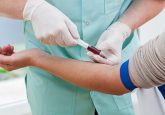Flexible, wearable biosensor tracks chemical and electrophysiological signals simultaneously

The Chem-Phys patch, the first flexible wearable device that can monitor both biochemical and electrical signals in the human body, has been developed by engineers at the University of California (UC San Diego; CA, USA). As most commercial wearables only measure one signal, and almost none measure chemical signals, this biosensor represents a first in the field.
The development of the patch was a collaboration between a nanoengineering team led by Joseph Wang and an electrical engineering team led by Patrick Mercier (both UC San Diego). The two groups worked on the patch’s sensors and chemistry and the electronics and data transmission, respectively. Their findings are presented in Nature Communications.
“One of the overarching goals of our research is to build a wearable tricorder-like device that can measure simultaneously a whole suite of chemical, physical and electrophysiological signals continuously throughout the day,” commented Mercier. “This research represents an important first step to show this may be possible.”
The device, which can be worn on the chest and communicates wirelessly with a smartphone, smart watch or laptop, records electrocardiogram signals and lactate concentration in real time. It could therefore have a range of applications, such as permitting athletes to monitor workouts and physicians to monitor patients with heart disease.
Additionally, there has been interest in the sensors from Olympic athletes for whom the patch could be particularly useful when striving to improve their performance. The biosensor has also generated excitement from physicians working with Wang and Mercier, who are interested in analysing data collected by the device and exploring whether electrical and chemical signals correlate.
“The ability to sense both EKG and lactate in a small wearable sensor could provide benefits in a variety of areas,” explained Kevin Patrick, a physician and director of the Center for Wireless and Population Health Systems at UC San Diego, who was not involved with the research.
“There would certainly be interest in the sports medicine community about how this type of sensing could help optimize training regimens for elite athletes,” added Patrick. “The ability to concurrently assess EKG and lactate could also open up some interesting possibilities in preventing and/or managing individuals with cardiovascular disease.”
In the future the teams hope to improve connections between the patch and the circuit board to which the biosensor is connected. There is also the potential to add sensors for additional markers, such as magnesium and potassium, and other vital signs.
Source: Imani S, Bandodkar AJ, Vinu Mohan AM et al.. A wearable chemical-electrophysiological hybrid biosensing system for real-time health and fitness monitoring. Nat. Commun. 7, 11650 (2016); UC San Diego press release





